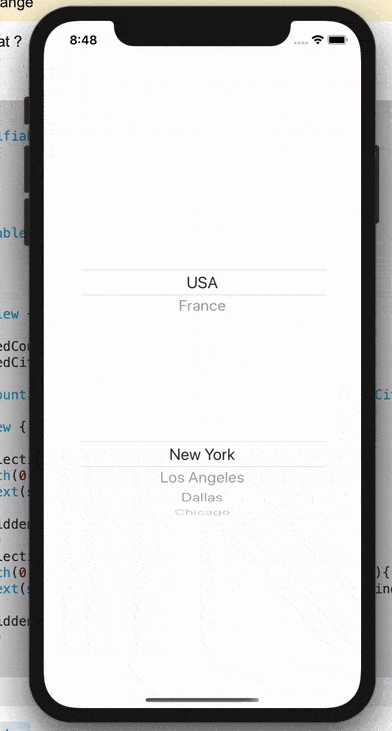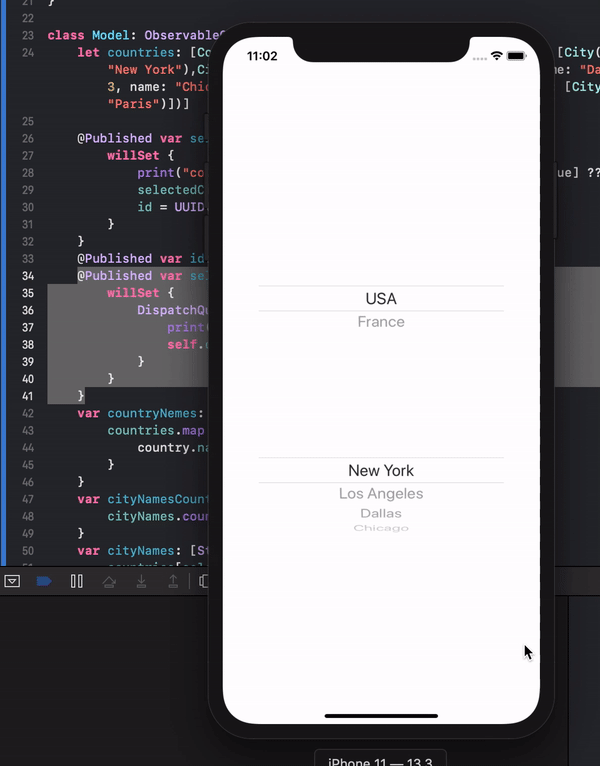The trick is to “recreate” the “slave” picker when you select a different country
In your example selection made by user change the state variable, but SwiftUI will recreate only view which is depending on this state variable. SwiftUI don’t have any idea why to recreate the second Picker View. I did it “manually”, by calling its .id() in case it must be done (the coutry was changed)
What information Apple gives us about View.id() ..
@available(iOS 13.0, OSX 10.15, tvOS 13.0, watchOS 6.0, *)
extension View {
/// Returns a view whose identity is explicitly bound to the proxy
/// value `id`. When `id` changes the identity of the view (for
/// example, its state) is reset.
@inlinable public func id<ID>(_ id: ID) -> some View where ID : Hashable
}
This is “full” single View iOS app, be careful, it will not run in Playground
//
// ContentView.swift
// tmp034
//
// Created by Ivo Vacek on 05/02/2020.
// Copyright © 2020 Ivo Vacek. NO rights reserved.
//
import Foundation
import SwiftUI
struct Country: Identifiable {
var id: Int = 0
var name: String
var cities: [City]
}
struct City: Identifiable {
var id: Int = 0
var name: String
}
class Model: ObservableObject {
let countries: [Country] = [Country(id: 0, name: "USA", cities: [City(id: 0, name: "New York"),City(id: 1, name: "Los Angeles"),City(id: 2, name: "Dallas"),City(id: 3, name: "Chicago")]),Country(id: 1, name: "France", cities: [City(id: 0, name: "Paris")])]
@Published var selectedContry: Int = 0 {
willSet {
selectedCity = 0
id = UUID()
print("country changed")
}
}
@Published var id: UUID = UUID()
@Published var selectedCity: Int = 0
var countryNemes: [String] {
countries.map { (country) in
country.name
}
}
var cityNamesCount: Int {
cityNames.count
}
var cityNames: [String] {
countries[selectedContry].cities.map { (city) in
city.name
}
}
}
struct ContentView: View {
@ObservedObject var model = Model()
var body: some View {
return VStack {
Picker(selection: $model.selectedContry, label: Text("")){
ForEach(0 ..< model.countryNemes.count){ index in
Text(self.model.countryNemes[index])
}
}.labelsHidden()
.clipped()
Picker(selection: $model.selectedCity, label: Text("")){
ForEach(0 ..< model.cityNamesCount){ index in
Text(self.model.cityNames[index])
}
}
// !! changing views id force SwiftUI to recreate it !!
.id(model.id)
.labelsHidden()
.clipped()
}
}
}
struct ContentView_Previews: PreviewProvider {
static var previews: some View {
ContentView()
}
}
UPDATE
It could be even better if the current city selection will persist between different country selections.
Lets try to update our model and logic.
first add the storage
private var citySelections: [Int: Int] = [:]
and next update the model with new versions of
@Published var selectedContry: Int = 0 {
willSet {
print("country changed", newValue, citySelections[newValue] ?? 0)
selectedCity = citySelections[newValue] ?? 0
id = UUID()
}
}
@Published var selectedCity: Int = 0 {
willSet {
DispatchQueue.main.async { [newValue] in
print("city changed", newValue)
self.citySelections[self.selectedContry] = newValue
}
}
}
And HURRA!!! Now it is much more better!
Maybe you ask why
DispatchQueue.main.async { [newValue] in
print("city changed", newValue)
self.citySelections[self.selectedContry] = newValue
}
The answer is simple. “recreating” second Picker will reset its internal state, and because its selection is bind to our model, it will be reset to its initial state. The trick is postpone update of this property AFTER SwiftUI recreate it.

